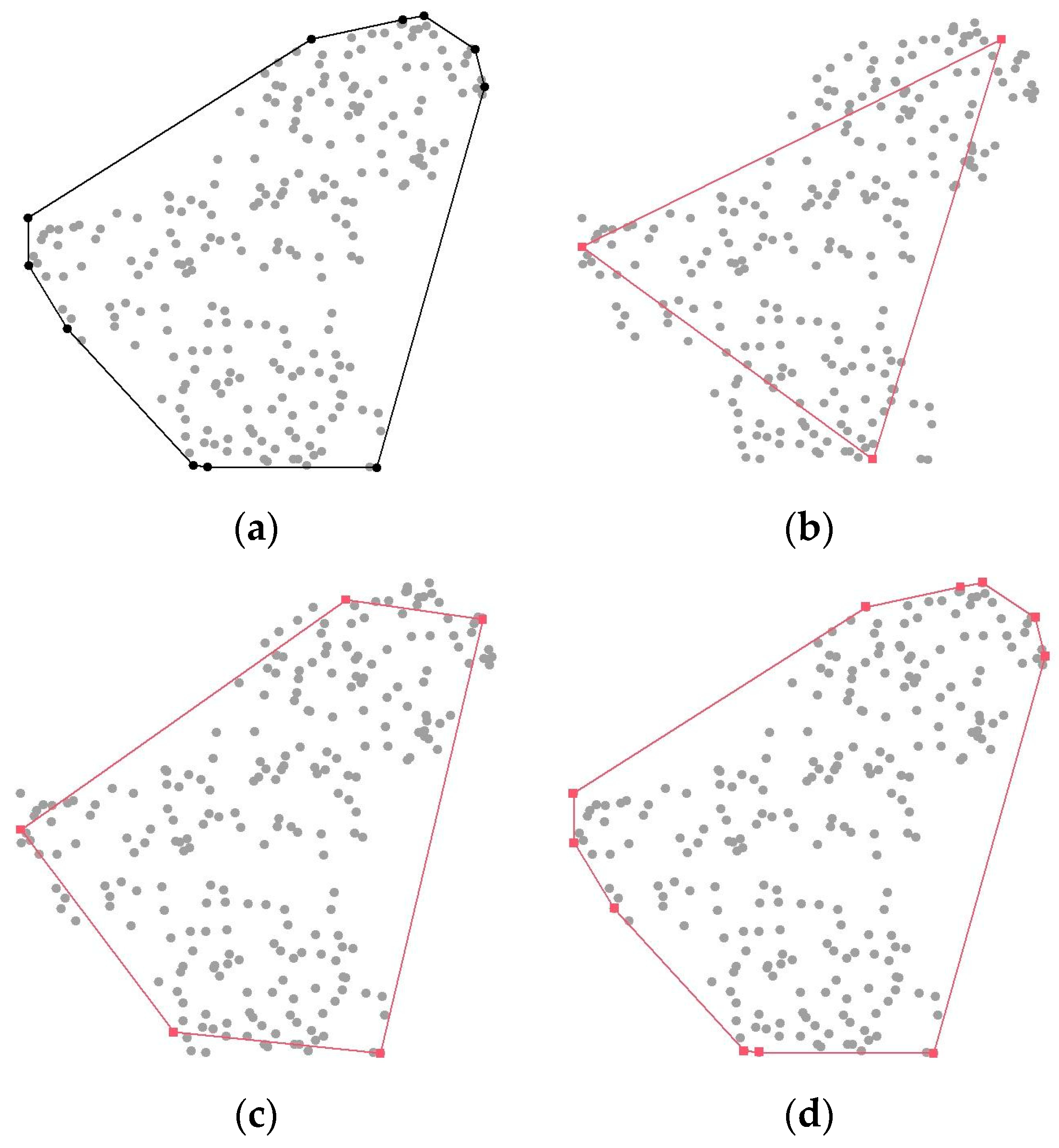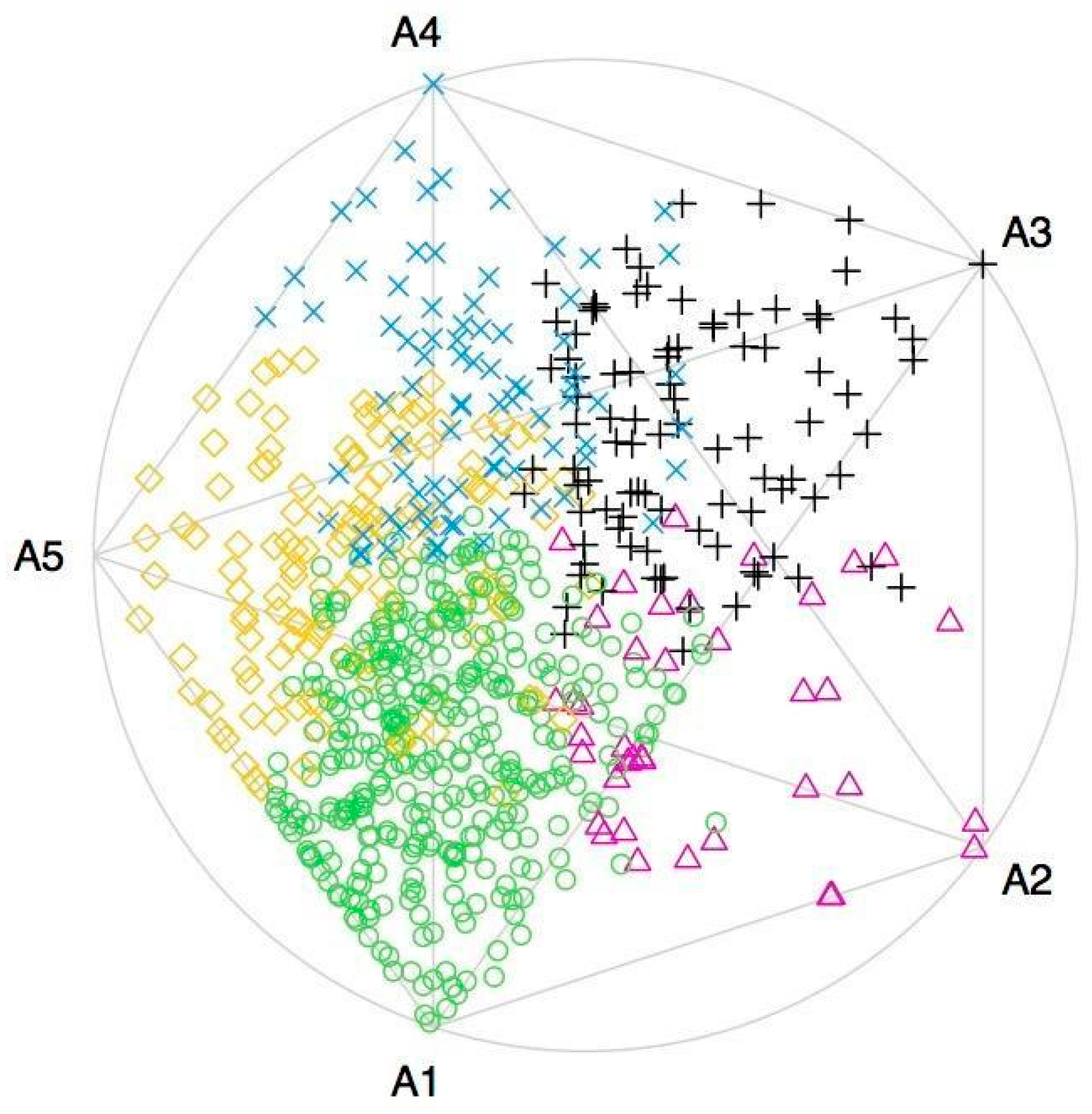Analysis of Archetypes to Determine Time Use and Workload Profiles of Spanish University Professors
Abstract
:1. Introduction
2. Materials and Methods
2.1. Sample and Instruments
2.2. Statistical Technique: Archetype Analysis
3. Results and Discussion
4. Conclusions
Author Contributions
Funding
Institutional Review Board Statement
Informed Consent Statement
Data Availability Statement
Conflicts of Interest
References
- Rubiano-Matulevich, E.; Viollaz, M. Gender Differences in Time Use: Allocating Time between the Market and the Household; Policy Research Working Paper; No. 8981; World Bank: Washington, DC, USA, 2019; Available online: https://openknowledge.worldbank.org/handle/10986/32274 (accessed on 8 March 2023).
- Misra, J.; Lundquist, J.H.; Holmes, E.; Agiomavritis, S. The ivory ceiling of service work. Academe 2011, 97, 22–26. [Google Scholar]
- O’Meara, K.; Kuvaeva, A.; Nyunt, G.; Waugaman, C.; Jackson, R. Asked More Often: Gender Differences in Faculty Workload in Research Universities and the Work Interactions That Shape Them. Am. Educ. Res. J. 2017, 54, 1154–1186. [Google Scholar] [CrossRef]
- Cabero, I.; Epifanio, I. A Data Science Analysis of Academic Staff Workload Profiles in Spanish Universities: Gender Gap Laid Bare. Educ. Sci. 2021, 11, 317. [Google Scholar] [CrossRef]
- Schiebinger, L.; Gilmartin, S.K. Housework is an academic issue. Academe 2010, 96, 39–44. [Google Scholar]
- Smidt, T.B.; Pétursdóttir, G.M.; Einarsdóttir, Þ. How do you take time? Work–life balance policies versus neoliberal, social and cultural incentive mechanisms in Icelandic higher education. Eur. Educ. Res. J. 2017, 16, 123–140. [Google Scholar] [CrossRef]
- Altuzarra Artola, A.; Gálvez Gálvez, C.; González Flores, A.M. Diferencias de género en la distribución del tiempo de trabajo en las regiones españolas. Rev. Int. Sociol. 2018, 76, e105. [Google Scholar] [CrossRef]
- Cutler, A.; Breiman, L. Archetypal Analysis. Technometrics 1994, 36, 338–347. [Google Scholar] [CrossRef]
- Allen, H.L. Faculty Workload and Productivity: Gender Comparisons. In The NEA 1998 Almanac of Higher Education; National Education Assn: Washington, DC, USA, 1998; pp. 29–44. [Google Scholar]
- Wohlrabe, K.; Gralka, S. Using archetypoid analysis to classify institutions and faculties of economics. Scientometrics 2020, 123, 159–179. [Google Scholar] [CrossRef] [Green Version]
- Kazanidis, I.; Theodosiou, T.; Petasakis, I.; Valsamidis, S. Online courses assessment through measuring and archetyping of usage data. Interact. Learn. Environ. 2016, 24, 472–486. [Google Scholar] [CrossRef]
- Theodosiou, T.; Kazanidis, I.; Valsamidis, S.; Kontogiannis, S. Courseware usage archetyping. In Proceedings of the 17th Panhellenic Conference on Informatics, Thessaloniki, Greece, 19–21 September 2013; pp. 243–249. [Google Scholar]
- Cabero, I.; Epifanio, I. Finding archetypal patterns for binary questionnaires. SORT 2020, 44, 39–66. [Google Scholar]
- Fernández, D.; Epifanio, I.; McMillan, L.F. Archetypal analysis for ordinal data. Inf. Sci. 2021, 579, 281–292. [Google Scholar] [CrossRef]
- Cabero, I.; Castelló, A.; Ortega, B. Búsqueda de arquetipos en la relación didáctica del razonamiento proporcional con otros contenidos matemáticos. In Entornos Virtuales para la Educación en Tiempos de Pandemia: Perspectivas Metodológicas; Dykinson: Madrid, Spain, 2021; pp. 397–416. [Google Scholar]
- Epifanio, I. Cargas de trabajo no presencial ECTS arquetípicas del estudiantado: ¿cómo se reparten el trabajo semanalmente. In En Actas del Congreso Virtual: Avances en Tecnologías, Innovación y Desafíos de la Educación Superior ATIDES 2016; Jaume I Universitat: Castelló de la Plana, Spain, 2016; pp. 367–376. [Google Scholar]
- Epifanio, I. Análisis de arquetipos de las respuestas del estudiantado a las encuestas docentes. In En Actas del Congreso Virtual: Avances en Tecnologías, Innovación y Desafíos de la Educación Superior ATIDES 2018; Jaume I Universitat: Castelló de la Plana, Spain, 2018; pp. 139–149. [Google Scholar]
- Cadwell, J. Archetypal Analysis. R-Bloggers. 2012. Available online: https://www.r-bloggers.com/2012/07/archetypal-analysis/ (accessed on 16 January 2023).
- Davis, T.; Love, B.C. Memory for category information is idealized through contrast with competing options. Psychol. Sci. 2010, 21, 234–242. [Google Scholar] [CrossRef] [Green Version]
- Thurau, C.; Kersting, K.; Wahabzada, M.; Bauckhage, C. Descriptive matrix factorization for sustainability adopting the principle of opposites. Data Min. Knowl. Discov. 2012, 24, 325–354. [Google Scholar] [CrossRef]
- Li, S.; Wang, P.Z.; Louviere, J.J.; Carson, R. Archetypal analysis: A new way to segment markets based on extreme individuals. In Proceedings of the Australian and New Zealand Marketing Academy Conference, ANZMAC, Adelaide, Australia, 1–3 December 2003. [Google Scholar]
- Porzio, G.C.; Ragozini, G.; Vistocco, D. On the use of archetypes as benchmarks. Appl. Stoch. Model. Bus. Ind. 2008, 24, 419–437. [Google Scholar] [CrossRef]
- Jabbaz, M.; Samper-Gras, T.; Díaz, C. La brecha salarial de género en las instituciones científicas. Estudio de caso. Convergencia 2019, 26, 1–27. [Google Scholar] [CrossRef]
- Hanasono, L.K.; Broido, E.M.; Yacobucci, M.M.; Root, K.V.; Peña, S.; O’Neil, D.A. Secret service: Revealing gender biases in the visibility and value of faculty service. J. Divers. High. Educ. 2019, 12, 85. [Google Scholar] [CrossRef] [Green Version]
- Heijstra, T.M.; Steinthorsdóttir, F.S.; Einarsdóttir, T. Academic career making and the double-edged role of academic housework. Gend. Educ. 2017, 29, 764–780. [Google Scholar] [CrossRef]
- Heijstra, T.M.; Einarsdóttir, Þ.; Pétursdóttir, G.M.; Steinþórsdóttir, F.S. Testing the concept of academic housework in a European setting: Part of academic career-making or gendered barrier to the top? Eur. Educ. Res. J. 2017, 16, 200–214. [Google Scholar] [CrossRef]
- Bird, S.R. Unsettling universities’ incongruous, gendered bureaucratic structures: A case-study approach. Gender Work Organ. 2011, 18, 202–230. [Google Scholar] [CrossRef]
- Seth, S.; Eugster, M.J.A. Probabilistic archetypal analysis. Mach. Learn. 2016, 102, 85–113. [Google Scholar] [CrossRef] [Green Version]
- Comisión de Mujeres y Matemáticas de la Real Sociedad Matemática Española. Stop Discriminación. 2020. Available online: https://mym.rsme.es/images/docs/mym/stop.pdf (accessed on 16 January 2023).
- Antecol, H.; Bedard, K.; Stearns, J. Equal but inequitable: Who benefits from gender-neutral tenure clock stopping policies? Am. Econ. Rev. 2018, 108, 2420–2441. [Google Scholar] [CrossRef] [Green Version]
- Criado Perez, C. Invisible Women: Data Bias in a World Designed for Men; Abrams: London, UK, 2019. [Google Scholar]
- Gibney, E. Teaching load could put female scientists at career disadvantage. Nature 2017, 10. [Google Scholar] [CrossRef]
- García-Gallego, A.; Georgantzís, N.; Martín-Montaner, J.; Pérez-Amaral, T. (How) Do research and administrative duties affect university professors’ teaching? Appl. Econ. 2015, 47, 4868–4883. [Google Scholar] [CrossRef] [Green Version]
- López Belloso, M.; Silvestre Cabrera, M.; García Muñoz, I. Igualdad de Género en instituciones de educación superior e investigación. Investig. Fem. 2021, 12, 263–270. [Google Scholar] [CrossRef]
- Reverter-Bañon, S. La igualdad de género en la universidad. Capitalismo académico y rankings globales. Investig. Fem. 2021, 12, 271–281. [Google Scholar] [CrossRef]
- Sánchez Nimo, S.M. La evaluación de los planes de igualdad en la Universidad de las Illes Balears: Una propuesta para la inclusión de un sistema de indicadores sensibles al género. Investig. Fem. 2021, 12, 439–448. [Google Scholar] [CrossRef]
- Calvo-Iglesias, E.; Epifanio, I.; Estradé, S.; Mas de les Valls, E. Gender Perspective in STEM Disciplines in Spain Universities. In Women in STEM in Higher Education; Springer: Singapore, 2022. [Google Scholar] [CrossRef]
- Mas de les Valls, E.; Peña, M.; Olmedo-Torre, N.; Lusa, A. Learnings from gender in teaching courses: Main needs and resistances. In Proceedings of the ICERI2022 Proceedings, 15th Annual International Conference of Education, Research and Innovation, IATED, Seville, Spain, 7–9 November 2022; pp. 4595–4601. [Google Scholar] [CrossRef]
- García-Holgado, A.; González-González, C.S.; García-Peñalvo, F.J. Introduction of the gender perspective in the university teaching: A study about inclusive language in Spanish. In Proceedings of the 2021 IEEE Global Engineering Education Conference (EDUCON), Vienna, Austria, 21–23 April 2021; pp. 1669–1673. [Google Scholar] [CrossRef]
- Conesa Carpintero, E.; González Ramos, A.M. Accelerated researchers: Psychosocial risks in gendered institutions in academia. Front. Psychol. 2018, 9, 1077. [Google Scholar] [CrossRef] [PubMed]




| = Teaching Hours | = Research Hours | = Management Hours | = Home and Personal Care Hours | |
|---|---|---|---|---|
| 12.26 | 0 | 0 | 2.57 | |
| 14.61 | 14.63 | 40.02 | 14.86 | |
| 14.98 | 4.11 | 0 | 99.03 | |
| 12.43 | 59.65 | 0.4 | 5.69 | |
| 70.94 | 11.25 | 4.12 | 21.86 |
| Group G1 (Minimal Effort) (Archetype 1) | Group G2 (High Management) (Archetype 2) | Group G3 (High Domestic) (Archetype 3) | Group G4 (High Research) (Archetype 4) | Group G5 (High Teaching) (Archetype 5) |
|---|---|---|---|---|
| 353 (50%) | 39 (6%) | 93 (13%) | 85 (12%) | 133 (19%) |
| Group G1 (Minimal Effort) (Archetype 1) | Group G2 (High Management) (Archetype 2) | Group G3 (High Domestic) (Archetype 3) | Group G4 (High Research) (Archetype 4) | Group G5 (High Teaching) (Archetype 5) | |
|---|---|---|---|---|---|
| Men (347) | 208 (60%) | 15 (4%) | 36 (10%) | 41 (12%) | 47 (14%) |
| Women (356) | 145 (41%) | 24 (7%) | 57 (16%) | 44 (12%) | 86 (24%) |
| Group G1 (Minimal Effort) (Archetype 1) | Group G2 (High Management) (Archetype 2) | Group G3 (High Domestic) (Archetype 3) | Group G4 (High Research) (Archetype 4) | Group G5 (High Teaching) (Archetype 5) |
| 197 (28%) | 9 (1%) | 38 (5%) | 37 (5%) | 69 (10%) |
| Group G1-2 (minimal effort-high management) (archetypes 1-2) | Group G1-3 (minimal effort-high domestic) (archetypes 1-3) | Group G1-4 (minimal effort-high research) (archetypes 1-4) | Group G1-5 (minimal effort-high teaching) (archetypes 1-5) | Group G2-3 (high management and domestic) (archetypes 2-3) |
| 25 (4%) | 33 (5%) | 73 (10%) | 99 (14%) | 15 (2%) |
| Group G2-4 (high management and research) (archetypes 2-4) | Group G2-5 (high management and teaching) (archetypes 25) | Group G3-4 (high domestic and research) (archetypes 3-4) | Group G3-5 (high domestic and teaching) (archetypes 3-5) | Group G4-5 (high research and teaching) (archetypes 4-5) |
| 4 (1%) | 11 (2%) | 27 (4%) | 30 (4%) | 33 (5%) |
| Group G1 (Minimal Effort) | Group G2 (High Management) | Group G3 (High Domestic) | Group G4 (High Research) | Group G5 (High Teaching) | |
| Men | 123 | 6 | 9 | 19 | 22 |
| Women | 74 | 3 | 29 | 18 | 47 |
| Group G1-2 (minimal effort–high management) | Group G1-3 (minimal effort–high domestic) | Group G1-4 (minimal effort–high research) | Group G1-5 (minimal effort–high teaching) | Group G2-3 (high management and domestic) | |
| Men | 12 | 12 | 42 | 50 | 6 |
| Women | 13 | 21 | 31 | 49 | 9 |
| Group G2-4 (high management and research) | Group G2-5 (high management and teaching) | Group G3-4 (high domestic and research) | Group G3-5 (high domestic and teaching) | Group G4-5 (high research and teaching) | |
| Men | 2 | 5 | 14 | 10 | 14 |
| Women | 2 | 6 | 13 | 20 | 19 |
Disclaimer/Publisher’s Note: The statements, opinions and data contained in all publications are solely those of the individual author(s) and contributor(s) and not of MDPI and/or the editor(s). MDPI and/or the editor(s) disclaim responsibility for any injury to people or property resulting from any ideas, methods, instructions or products referred to in the content. |
© 2023 by the authors. Licensee MDPI, Basel, Switzerland. This article is an open access article distributed under the terms and conditions of the Creative Commons Attribution (CC BY) license (https://creativecommons.org/licenses/by/4.0/).
Share and Cite
Cabero, I.; Epifanio, I.; Gual-Arnau, X. Analysis of Archetypes to Determine Time Use and Workload Profiles of Spanish University Professors. Educ. Sci. 2023, 13, 295. https://doi.org/10.3390/educsci13030295
Cabero I, Epifanio I, Gual-Arnau X. Analysis of Archetypes to Determine Time Use and Workload Profiles of Spanish University Professors. Education Sciences. 2023; 13(3):295. https://doi.org/10.3390/educsci13030295
Chicago/Turabian StyleCabero, Ismael, Irene Epifanio, and Ximo Gual-Arnau. 2023. "Analysis of Archetypes to Determine Time Use and Workload Profiles of Spanish University Professors" Education Sciences 13, no. 3: 295. https://doi.org/10.3390/educsci13030295
APA StyleCabero, I., Epifanio, I., & Gual-Arnau, X. (2023). Analysis of Archetypes to Determine Time Use and Workload Profiles of Spanish University Professors. Education Sciences, 13(3), 295. https://doi.org/10.3390/educsci13030295








